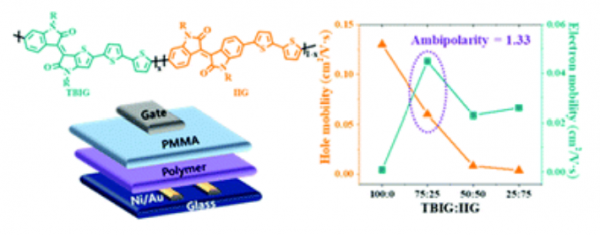Controlling the ambipolarity of thieno-benzo-isoindigo polymer-based transistors: the balance of face-on and edge-on populations
- 저자
- Jungho Lee, Eun-Sol Shin, Yeon-Ju Kim, Yong-Young Noh, Changduk Yang*
- 저널명
- Journal of Materials Chemistry C, 8, 296-302 (2020)
- 년도
- 2020
- Link
- https://doi.org/10.1039/C9TC05641F 325회 연결
[Abstract]
In spite of its interesting ‘asymmetric’ polar cyclic amide structure combining the dual properties of isoindigo (IIG) and thieno-isoindigo, the recently formulated thieno-benzo-isoindigo (TBIG) has been less explored as a building block for organic electronic materials in conjugated polymers. This article introduces the results obtained on TBIG-based polymers (PTBIG-100, PTBIG-75, PTBIG-50, and PTBIG-25) having different ratios of TBIG and IIG accepting units and a bithiophene counterpart donor to highlight their fundamental characteristics in terms of the organic field-effect transistor (OFET) mobilities. Besides, an increase in the TBIG unit results in increased co-planarity, red-shifted absorption, and higher-lying highest occupied molecular orbital levels as well as higher face-on crystallite populations relative to edge-on ones. All the polymer-based OFETs exhibit ambipolar charge transport properties; PTBIG-100 adopting a highly face-on orientation exhibits the highest hole mobility of 0.13 cm2 V−1 s−1 but rather low electron mobility, while the opposite is true for PTBIG-25 having a higher edge-on one. Besides, highly balanced hole and electron mobilities (μFET,h = 0.06 cm2 V−1 s−1 and μFET,e = 0.045 cm2 V−1 s−1) are observed for PTBIG-75 with a similar population between face-on and edge-on textures. Analysis of the electrical and structural properties in this study demonstrates that the ratio of face-on and edge-on is a key factor in not only determining the dominant polarity, but also achieving balanced ambipolarity in OFETs.
